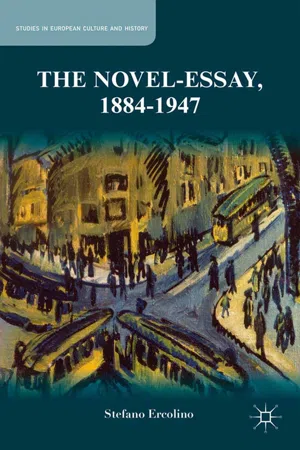
This is a test
- English
- ePUB (mobile friendly)
- Available on iOS & Android
eBook - ePub
The Novel-Essay, 1884-1947
Book details
Book preview
Table of contents
Citations
About This Book
The novel-essay emerged in France, in the last quarter of the nineteenth century, and reached its highest formal complexity in Austria and Germany, during the interwar period. Here, Ercolino argues that it is crucial for a renovated understating of the history of the novel in modernity.
Frequently asked questions
At the moment all of our mobile-responsive ePub books are available to download via the app. Most of our PDFs are also available to download and we're working on making the final remaining ones downloadable now. Learn more here.
Both plans give you full access to the library and all of Perlego’s features. The only differences are the price and subscription period: With the annual plan you’ll save around 30% compared to 12 months on the monthly plan.
We are an online textbook subscription service, where you can get access to an entire online library for less than the price of a single book per month. With over 1 million books across 1000+ topics, we’ve got you covered! Learn more here.
Look out for the read-aloud symbol on your next book to see if you can listen to it. The read-aloud tool reads text aloud for you, highlighting the text as it is being read. You can pause it, speed it up and slow it down. Learn more here.
Yes, you can access The Novel-Essay, 1884-1947 by S. Ercolino in PDF and/or ePUB format, as well as other popular books in History & World War II. We have over one million books available in our catalogue for you to explore.
Information
INDEX
adaptation tools, 51
Adorno, Theodor W., xvi, xviii
cognitive nature of art, 161n48
Doctor Faustus, influence on, 138–41, 143, 164nn8–9
essay form, 28–30, 49, 52, 53, 57, 84, 153n9, 157n6
Mann correspondence, 133, 134
music, 138–40, 144, 164nn6–9, 164n12
negative dialectic, 72, 75
novelty, 137
regression, 145, 146
Aesthetics (Hegel), 70, 156n33, 164n5
Against Nature (Huysmans), xvi, xvi–xvii
Bildungsroman discharge, 42–3, 45
character, 5–6, 9–10, 35–6, 59, 152n2
essayism, 5, 10–12, 38, 52, 54
naturalism and, 12–13, 37–8, 149n1
Schopenhauer’s influence, 21
synesthesia, 27–8
Akhsharumov, Nikolai, 162n71
Albertazzi, Silvia, 153n7
Alexander, Samuel, 31–2
“Allegory and History” (Jameson), 144–5
Allison, Sarah, 32–3
anacrisis, 58, 59
The Analysis of Sensations (Mach), 88
“The Anarchist (1903)” (Broch), 109, 112, 114, 131
See also The Sleepwalkers
aphorism, 52, 98
“An Apology for Raymond Sebond” (Montaigne), 80
Aristotle, 24, 67, 70
L’Assommoir (Zola), 7
naturalism and, 3, 4, 8–9, 13
plot, 5, 8
Auerbach, Erich, 61–2, 69
Austen, Jane, 92
Austria
Austro-Hungarian Empire, xviii, 47, 102, 118, 121, 162n62
Habsburg myth, 119–22, 123, 162n61
intellectual atmosphere, 22, 81, 89
novel-essay emergence, xv
autofiction, 18, 147
Avelli...
Table of contents
- Cover
- Title
- One
- Two
- Three
- Four
- Notes
- Works Cited
- Index